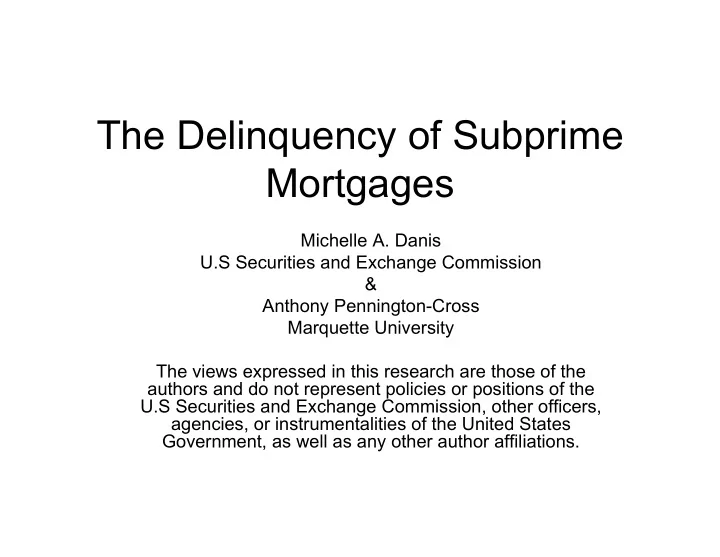

The Delinquency of Subprime Mortgages Michelle A. Danis U.S Securities and Exchange Commission & Anthony Pennington-Cross Marquette University The views expressed in this research are those of the authors and do not represent policies or positions of the U.S Securities and Exchange Commission, other officers, agencies, or instrumentalities of the United States Government, as well as any other author affiliations.
Subprime Literature • Where and when is subprime used? – High-risk locations • Low-income, minority census tracts • High foreclosure rate census tracts • High proportion of individuals with “very low credit score” • Lower house price appreciation areas – Less knowledgeable and high transition rates • Performance – Higher default for third party originations – Less responsive to interest rates – Higher loss severity – Hybrids terminate early 2
Option Theory Literature • Traditional mortgage model – Default, prepay, current (continue or alive) – Ruthless default • Value of delay -- option pricing framework – Kau and Keenan, REE 1994 – Ambrose, Buttimer, and Capone, JMCB1997 • Expected and realized value of property matters • Delay of foreclosure assumed exogenous • Longer delay and higher LTV -- leads to default – Short delay and more variance -- leads to default – Long delay and v ery high variance ↔ Prob(default) ↓ 3
30-years of Delinquency Research • Examine one or two states of delinquency in isolation – Assume Independence – Ignore competing risks • Termination (default or prepayment) – Remarkable consistent results • LTV at origination • Income • Other financial assets • Contemporaneous economic conditions – Housing and labor market • Credit scores • Lender behavior/characteristics 4
Nested Logit Model Loan Performance Loan Performance “branches” “branches” terminate terminate current current indexed by l indexed by l delinquent delinquent outcomes in outcomes in prepay prepay default default 30 30 60 60 90 90 current current “nests” “nests” late late late late late late indexed by j indexed by j 5
90+ Days Delinquent 90 Late Frequency 4 3.5 Frequency (percentage) 3 2.5 Sample 2 MBA 1.5 1 0.5 0 9 9 9 9 0 0 0 0 1 1 1 1 2 2 2 2 3 3 9 9 9 9 0 0 0 0 0 0 0 0 0 0 0 0 0 0 9 9 9 9 0 0 0 0 0 0 0 0 0 0 0 0 0 0 1 1 1 1 2 2 2 2 2 2 2 2 2 2 2 2 2 2 Q Q Q Q Q Q Q Q Q Q Q Q Q Q Q Q Q Q 1 2 3 4 1 2 3 4 1 2 3 4 1 2 3 4 1 2 Quarter 6
90+ Days Delinquent and Age of Loan 1.0% -- -- -- -- Nested Logit ___________ Multinomial Logit 0.9% 0.8% 0.7% 0.6% Probability 0.5% 0.4% 0.3% 0.2% 0.1% 0.0% 0 10 20 30 40 50 60 7 Age of Loan in Months
90+ Days Delinquent and FICO 10% -- -- -- -- Nested Logit ___________ Multinomial Logit 9% 8% 7% 6% Probability 5% 4% 3% 2% 1% 0% 430 480 530 580 630 680 730 780 830 FICO 8
90+ Days Delinquent and House Prices 2.0% -- -- -- -- Nested Logit ___________ Multinomial Logit 1.8% 1.6% 1.4% 1.2% Probability 1.0% 0.8% 0.6% 0.4% 0.2% 0.0% -3% 7% 17% 27% 37% 47% 57% 67% 77% Change in House Price Index 9
90+ Days Delinquent & House Price Volatility 8% -- -- -- -- Nested Logit ___________ Multinomial Logit 7% 6% 5% Probability 4% 3% 2% 1% 0% 0.015 0.035 0.055 0.075 0.095 0.115 0.135 0.155 0.175 0.195 10 Standard Error of HPI
Elasticity Estimates Current 30-Late 90+-Late Default Prepaid Prepay Penalty 0.7% 7.0% 2.5% 2.6% -27.6% Low Doc -1.9% 87.6% 87.9% 19.8% 1.7% No Doc -5.8% 270.7% 336.8% 24.3% 5.8% The Recipe for Delinquency Young loans Moderately volatile and flat or declining house prices Low credit scores Low & no documentation 11
Recommend
More recommend